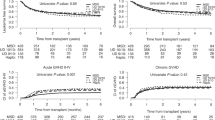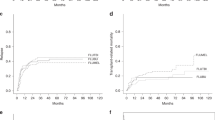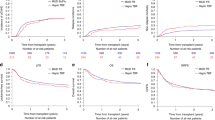Abstract
In this multicenter retrospective study, the long-term outcomes of 878 adults with AML and refractory anemia with excess blasts (RAEB) with BM blasts <10% who underwent transplantation with an HLA-identical sibling donor between 1998 and 2004 were analyzed according to four regimens of conditioning intensity: reduced-intensity conditioning (RIC) (either intermediate RIC (IntermRIC) or non-myeloablative (NMA) RIC), and myeloablative conditioning (MC) in 718 patients (either conventional MC or hyperintense MC. In multivariate cox analysis, patients undergoing NMA transplantation had lower non-relapse mortality risk in the first 100 days after transplantation (P<0.01), but a higher risk beyond day +100 (P=0.02), as well as higher relapse incidence in the first 12 months (P<0.01), but the risk was similar in all groups beyond 12 months. The probabilities of PFS and OS up to 7 years were significantly lower only in the NMA subgroup (P⩽0.01 for both). The 7-year OS was 53%, 29%, 56% and 51%, respectively. Our data suggest that prospective studies comparing RIC regimens (especially IntermRIC) with MC are appropriate in patients with AML and RAEB who are in a non-advanced disease status.
This is a preview of subscription content, access via your institution
Access options
Subscribe to this journal
Receive 12 print issues and online access
$259.00 per year
only $21.58 per issue
Buy this article
- Purchase on Springer Link
- Instant access to full article PDF
Prices may be subject to local taxes which are calculated during checkout



Similar content being viewed by others
References
Barrett AJ, Savani BN . Allogeneic stem cell transplantation for myelodysplastic syndrome. Semin Hematol 2008; 45: 49–59.
Gupta V, Tallman MS, He W, Logan BR, Copelan E, Gale RP et al. Comparable survival after HLA-well-matched unrelated or matched sibling donor transplantation for acute myeloid leukemia in first remission with unfavorable cytogenetics at diagnosis. Blood 2010; 116: 1839–1848.
Lioure B, Bene MC, Pigneux A, Huynh A, Chevallier P, Fegueux N et al. Early matched sibling hematopoietic cell transplantation for adult AML in first remission using an age-adapted strategy: long-term results of a prospective GOELAMS study. Blood 2012; 119: 2943–2948.
Blaise D, Vey N, Faucher C, Mohty M . Current status of reduced-intensity-conditioning allogeneic stem cell transplantation for acute myeloid leukemia. Haematologica 2007; 92: 533–541.
Niederwieser D, Lange T, Cross M, Basara N, Al-Ali H . Reduced intensity conditioning (RIC) haematopoietic cell transplants in elderly patients with AML. Best Pract Res Clin Haematol 2006; 19: 825–838.
Bacigalupo A, Ballen K, Rizzo D, Giralt S, Lazarus H, Ho V et al. Defining the intensity of conditioning regimens: working definitions. Biol Blood Marrow Transplant 2009; 15: 1628–1633.
Giralt S, Ballen K, Rizzo D, Bacigalupo A, Horowitz M, Pasquini M et al. Reduced-intensity conditioning regimen workshop: defining the dose spectrum. Report of a workshop convened by the center for international blood and marrow transplant research. Biol Blood Marrow Transplant 2009; 15: 367–369.
Khabori MA, El-Emary M, Xu W, Guyatt G, Galal A, Kuruvilla J et al. Impact of intensity of conditioning therapy in patients aged 40-60 years with AML/myelodysplastic syndrome undergoing allogeneic transplantation. Bone Marrow Transplant 2011; 46: 516–522.
Luger SM, Ringden O, Zhang MJ, Perez WS, Bishop MR, Bornhauser M et al. Similar outcomes using myeloablative vs reduced-intensity allogeneic transplant preparative regimens for AML or MDS. Bone Marrow Transplant 2012; 47: 203–211.
Shimoni A, Hardan I, Shem-Tov N, Yeshurun M, Yerushalmi R, Avigdor A et al. Allogeneic hematopoietic stem-cell transplantation in AML and MDS using myeloablative versus reduced-intensity conditioning: the role of dose intensity. Leukemia 2006; 20: 322–328.
Lee SE, Kim YJ, Yahng SA, Cho BS, Eom KS, Lee S et al. Survival benefits from reduced-intensity conditioning in allogeneic stem cell transplantation for young lower-risk MDS patients without significant comorbidities. Eur J Haematol 2011; 87: 510–520.
Aoudjhane M, Labopin M, Gorin NC, Shimoni A, Ruutu T, Kolb HJ et al. Comparative outcome of reduced intensity and myeloablative conditioning regimen in HLA identical sibling allogeneic haematopoietic stem cell transplantation for patients older than 50 years of age with acute myeloblastic leukaemia: a retrospective survey from the Acute Leukemia Working Party (ALWP) of the European group for Blood and Marrow Transplantation (EBMT). Leukemia 2005; 19: 2304–2312.
McClune BL, Weisdorf DJ, Pedersen TL, Tunes da SG, Tallman MS, Sierra J et al. Effect of age on outcome of reduced-intensity hematopoietic cell transplantation for older patients with acute myeloid leukemia in first complete remission or with myelodysplastic syndrome. J Clin Oncol 2010; 28: 1878–1887.
Ringden O, Labopin M, Ehninger G, Niederwieser D, Olsson R, Basara N et al. Reduced intensity conditioning compared with myeloablative conditioning using unrelated donor transplants in patients with acute myeloid leukemia. J Clin Oncol 2009; 27: 4570–4577.
de WT, Brand R, van BA, Mufti G, Ruutu T, Finke J et al. Allogeneic stem cell transplantation for patients with refractory anaemia with matched related and unrelated donors: delay of the transplant is associated with inferior survival. Br J Haematol 2009; 146: 627–636.
Martino R, Valcarcel D, Brunet S, Sureda A, Sierra J . Comparable non-relapse mortality and survival after HLA-identical sibling blood stem cell transplantation with reduced or conventional-intensity preparative regimens for high-risk myelodysplasia or acute myeloid leukemia in first remission. Bone Marrow Transplant 2008; 41: 33–38.
Martino R, Iacobelli S, Brand R, Jansen T, van BA, Finke J et al. Retrospective comparison of reduced-intensity conditioning and conventional high-dose conditioning for allogeneic hematopoietic stem cell transplantation using HLA-identical sibling donors in myelodysplastic syndromes. Blood 2006; 108: 836–846.
Lim Z, Brand R, Martino R, van BA, Finke J, Bacigalupo A et al. Allogeneic hematopoietic stem-cell transplantation for patients 50 years or older with myelodysplastic syndromes or secondary acute myeloid leukemia. J Clin Oncol 2010; 28: 405–411.
Hamadani M, Mohty M, Kharfan-Dabaja MA . Reduced-intensity conditioning allogeneic hematopoietic cell transplantation in adults with acute myeloid leukemia. Cancer Control 2011; 18: 237–245.
Horwitz ME . Reduced intensity versus myeloablative allogeneic stem cell transplantation for the treatment of acute myeloid leukemia, myelodysplastic syndrome and acute lymphoid leukemia. Curr Opin Oncol 2011; 23: 197–202.
Shimoni A, Nagler A . Optimizing the conditioning regimen for allogeneic stem-cell transplantation in acute myeloid leukemia; dose intensity is still in need. Best Pract Res Clin Haematol 2011; 24: 369–379.
Suciu S, Mandelli F, de WT, Zittoun R, Gallo E, Labar B et al. Allogeneic compared with autologous stem cell transplantation in the treatment of patients younger than 46 years with acute myeloid leukemia (AML) in first complete remission (CR1): an intention-to-treat analysis of the EORTC/GIMEMAAML-10 trial. Blood 2003; 102: 1232–1240.
Chevallier P, Labopin M, Milpied N, Cornelissen JJ, Blaise D, Petersen E et al. Impact of cytogenetics risk on outcome after reduced intensity conditioning allo-SCT from an HLA-identical sibling for patients with AML in first CR: a report from the acute leukemia working party of EBMT. Bone Marrow Transplant 2012; 47: 1442–1447.
Greenberg P, Cox C, LeBeau MM, Fenaux P, Morel P, Sanz G et al. International scoring system for evaluating prognosis in myelodysplastic syndromes. Blood 1997; 89: 2079–2088.
Gratwohl A . The EBMT risk score. Bone Marrow Transplant 2012; 47: 749–756.
Filipovich AH . Diagnosis and manifestations of chronic graft-versus-host disease. Best Pract Res Clin Haematol 2008; 21: 251–257.
Gratwohl A, Hermans J, Apperley J, Arcese W, Bacigalupo A, Bandini G et al. Acute graft-versus-host disease: grade and outcome in patients with chronic myelogenous leukemia. Working Party Chronic Leukemia of the European Group for Blood and Marrow Transplantation. Blood 1995; 86: 813–818.
Putter H, Fiocco M, Geskus RB . Tutorial in biostatistics: competing risks and multi-state models. Stat Med 2007; 26: 2389–2430.
Ruan PK, Gray RJ . Analyses of cumulative incidence functions via non-parametric multiple imputation. Stat Med 2008; 27: 5709–5724.
Gorin NC, Labopin M, Boiron JM, Theorin N, Littlewood T, Slavin S et al. Results of genoidentical hemopoietic stem cell transplantation with reduced intensity conditioning for acute myelocytic leukemia: higher doses of stem cells infused benefit patients receiving transplants in second remission or beyond--the Acute Leukemia Working Party of the European Cooperative Group for Blood and Marrow Transplantation. J Clin Oncol 2006; 24: 3959–3966.
Bornhauser M, Kienast J, Trenschel R, Burchert A, Hegenbart U, Stadler M et al. An intergroup randomised trial of standard intensity versus reduced intensity tbi-based conditioning in patients with acute myeloid leukemia in first complete remission. ASH Annual Meeting Abstracts 2011; 118: 157.
Stelljes M, Bornhauser M, Kroger M, Beyer J, Sauerland MC, Heinecke A et al. Conditioning with 8-Gy total body irradiation and fludarabine for allogeneic hematopoietic stem cell transplantation in acute myeloid leukemia. Blood 2005; 106: 3314–3321.
Valcarcel D, Martino R, Pinana JL, Sierra J . Allogeneic stem cell transplantation after reduced-intensity conditioning for acute myeloid leukaemia: impact of chronic graft-versus-host disease. Curr Opin Oncol 2009; 21 (Suppl 1): S35–S37.
Lim ZY, Ingram W, Brand R, Ho A, Kenyon M, Devereux S et al. Impact of pretransplant comorbidities on alemtuzumab-based reduced-intensity conditioning allogeneic hematopoietic SCT for patients with high-risk myelodysplastic syndrome and AML. Bone Marrow Transplant 2010; 45: 633–639.
Tauro S, Craddock C, Peggs K, Begum G, Mahendra P, Cook G et al. Allogeneic stem-cell transplantation using a reduced-intensity conditioning regimen has the capacity to produce durable remissions and long-term disease-free survival in patients with high-risk acute myeloid leukemia and myelodysplasia. J Clin Oncol 2005; 23: 9387–9393.
Gyurkocza B, Storb R, Storer BE, Chauncey TR, Lange T, Shizuru JA et al. Nonmyeloablative allogeneic hematopoietic cell transplantation in patients with acute myeloid leukemia. J Clin Oncol 2010; 28: 2859–2867.
Niederwieser D, Verdonck LF, Cornelissen JJ, Cross M, Krahl R, Lange T et al. Long term outcome after low dose tbi based conditioning hematopoietic stem cell transplantation (HSCT) from related and unrelated donors for older patients with AML. ASH Annual Meeting Abstracts 2011; 118: 2030.
Jagasia M, Arora M, Flowers ME, Chao NJ, McCarthy PL, Cutler CS et al. Risk factors for acute GVHD and survival after hematopoietic cell transplantation. Blood 2012; 119: 296–307.
Soiffer RJ, LeRademacher J, Ho V, Kan F, Artz A, Champlin RE et al. Impact of immune modulation with anti-T-cell antibodies on the outcome of reduced-intensity allogeneic hematopoietic stem cell transplantation for hematologic malignancies. Blood 2011; 117: 6963–6970.
Author information
Authors and Affiliations
Consortia
Corresponding author
Ethics declarations
Competing interests
The authors declare no conflict of interest.
Rights and permissions
About this article
Cite this article
Martino, R., de Wreede, L., Fiocco, M. et al. Comparison of conditioning regimens of various intensities for allogeneic hematopoietic SCT using HLA-identical sibling donors in AML and MDS with <10% BM blasts: a report from EBMT. Bone Marrow Transplant 48, 761–770 (2013). https://doi.org/10.1038/bmt.2012.236
Received:
Revised:
Accepted:
Published:
Issue Date:
DOI: https://doi.org/10.1038/bmt.2012.236
Keywords
This article is cited by
-
Comparison of reduced intensity and nonmyeloablative conditioning for adults with acute myeloid leukemia undergoing allogeneic hematopoietic cell transplantation in first or second remission
Bone Marrow Transplantation (2023)
-
Disruption of the oral microbiota is associated with a higher risk of relapse after allogeneic hematopoietic stem cell transplantation
Scientific Reports (2021)
-
Predicting non-relapse mortality following allogeneic hematopoietic cell transplantation during first remission of acute myeloid leukemia
Bone Marrow Transplantation (2021)
-
Long-term results of reduced-intensity conditioning allogeneic hematopoietic cell transplantation for older patients with acute myeloid leukemia: a retrospective analysis of 10-year follow-up data
Bone Marrow Transplantation (2020)
-
Impact of prophylactic/preemptive donor lymphocyte infusion and intensified conditioning for relapsed/refractory leukemia: a real-world study
Science China Life Sciences (2020)



